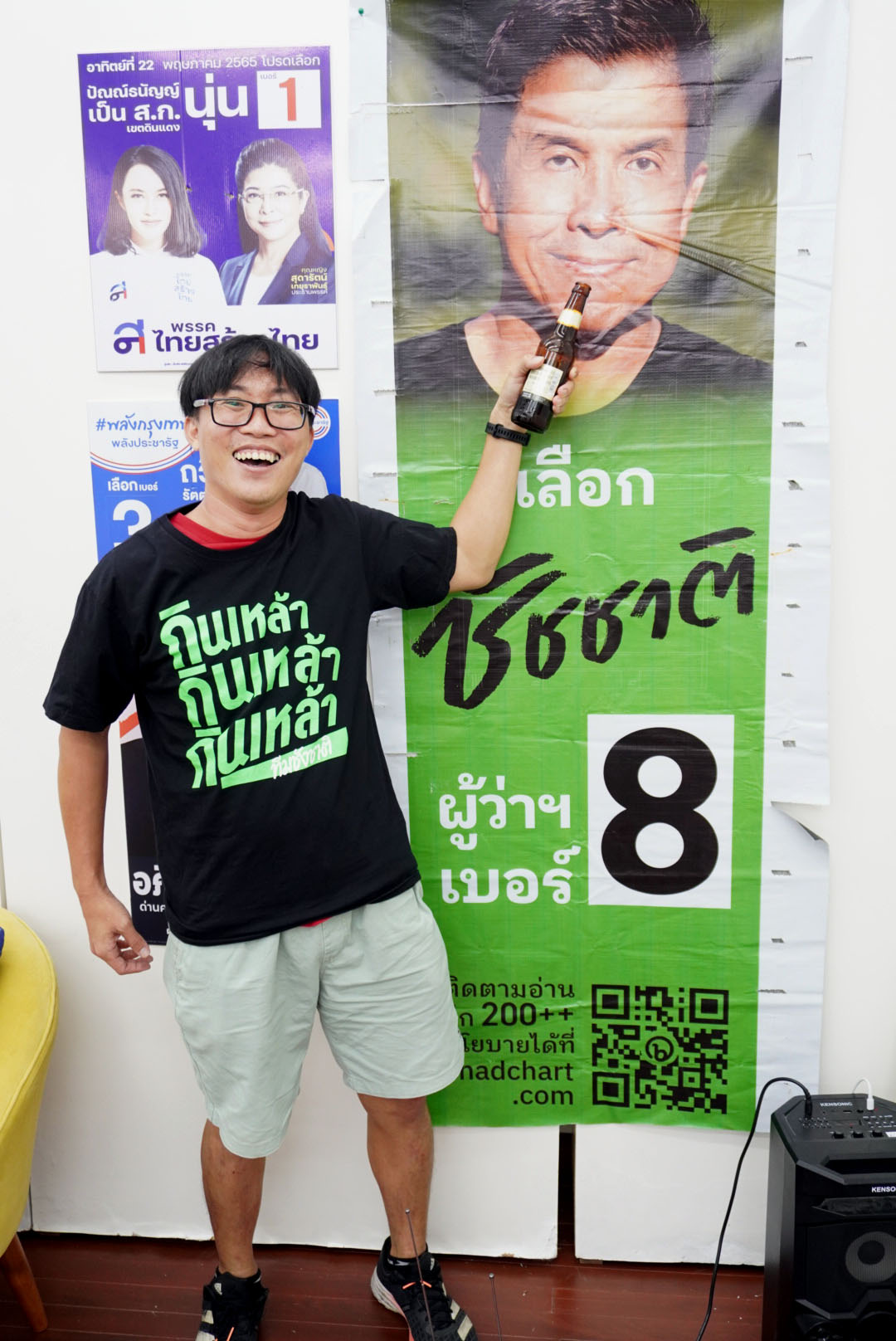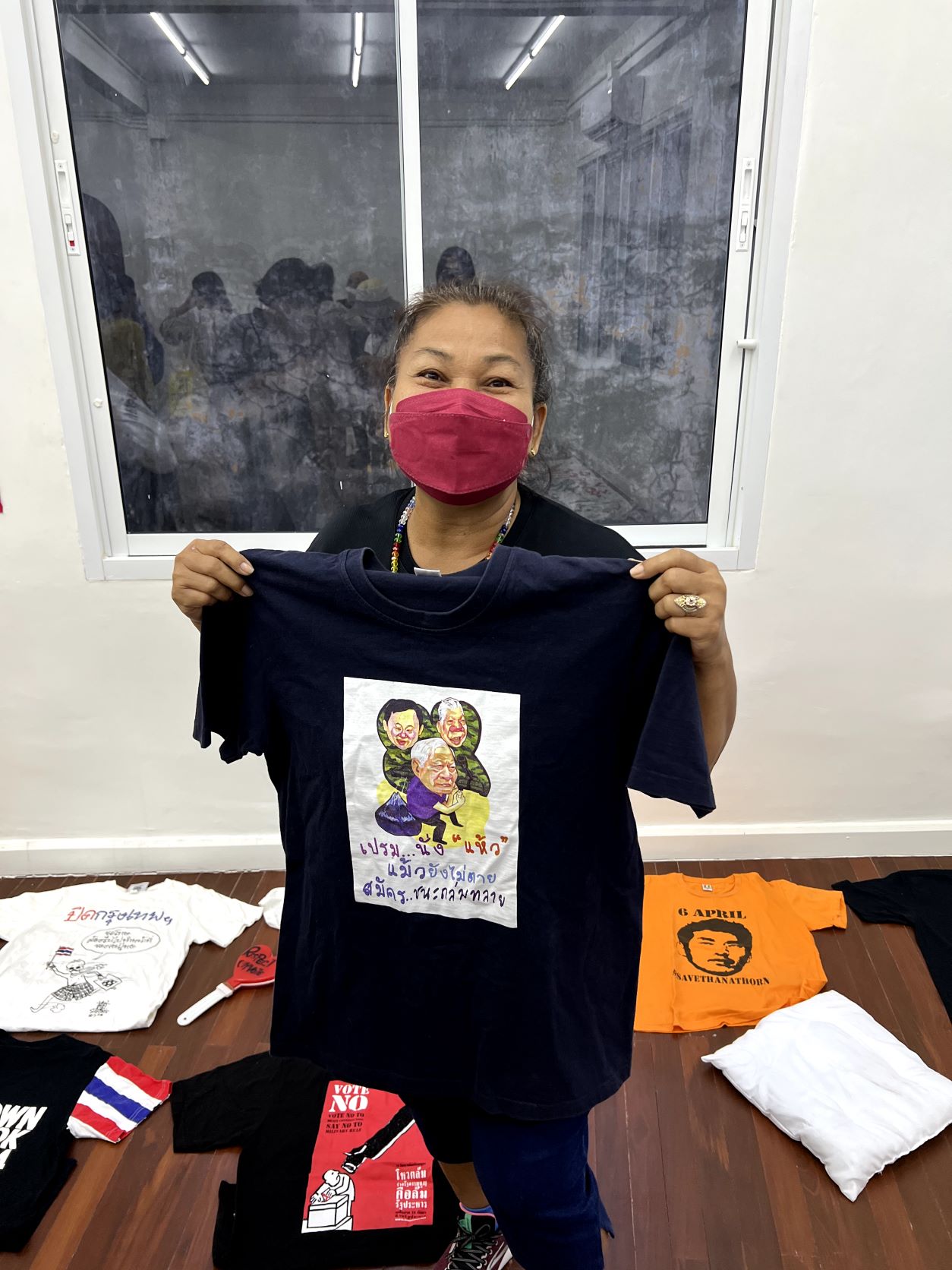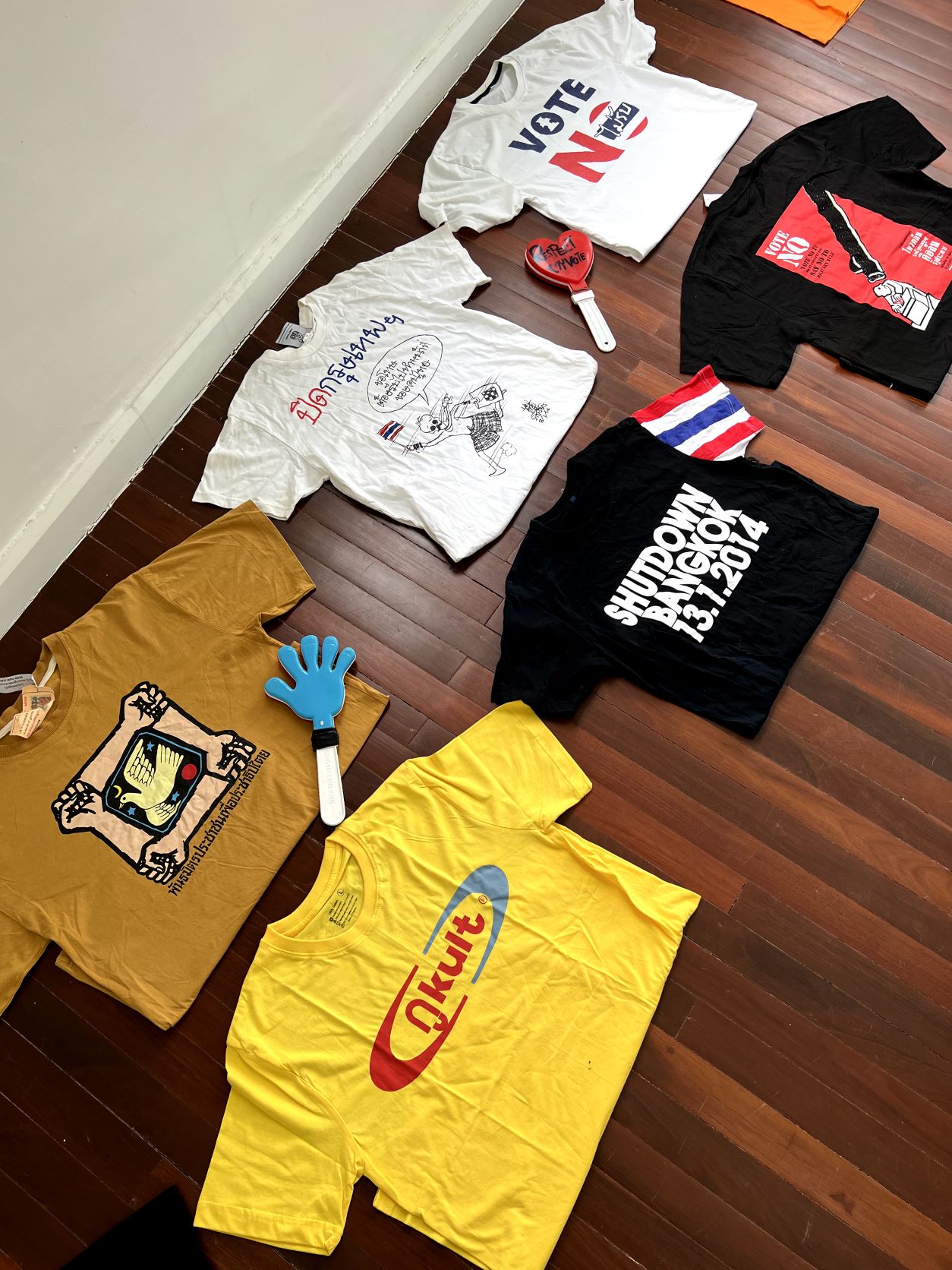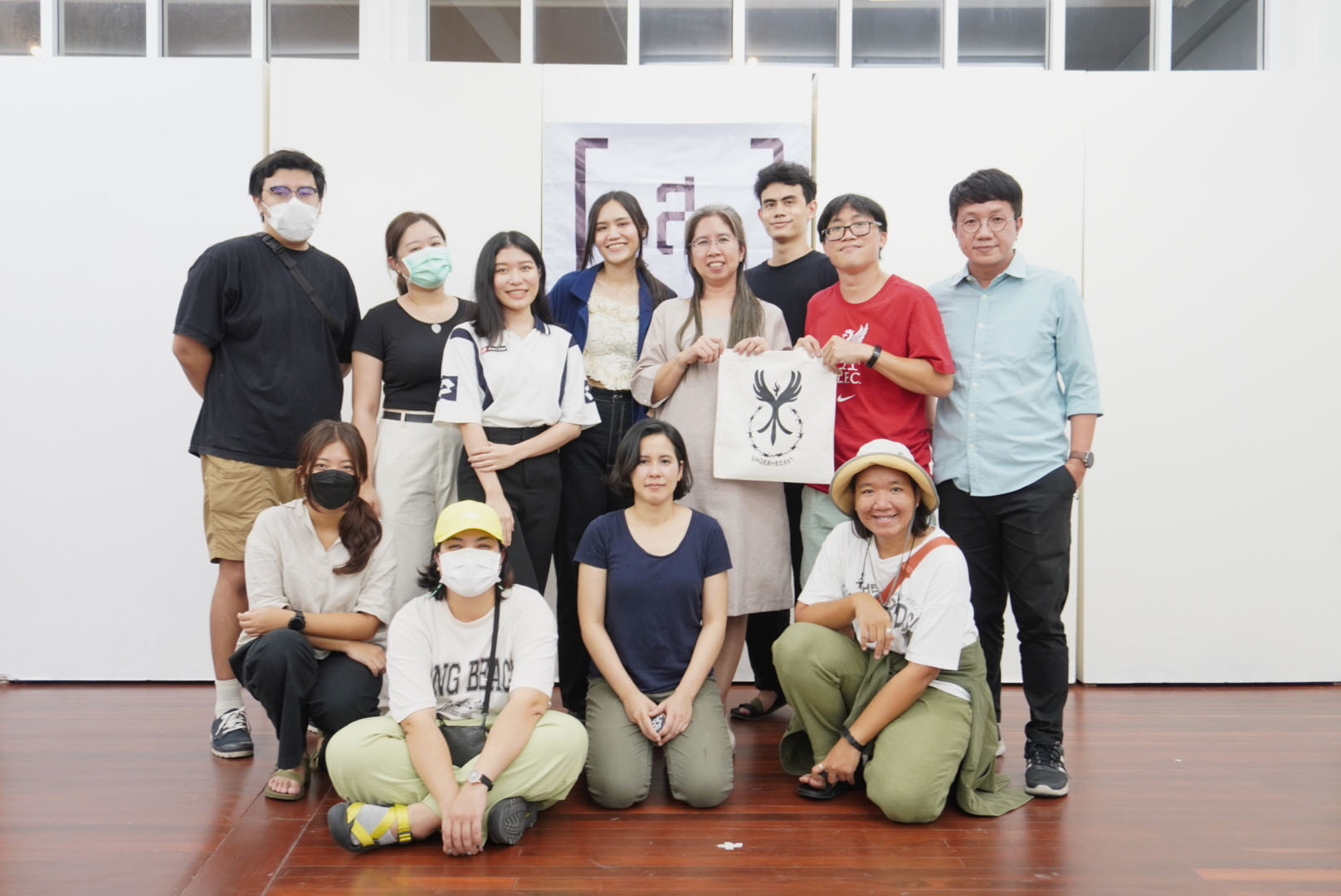First published in Thai on the Museum of Popular History
Reported by Awassada Treerayapiwat
Translated with additional reporting by Peera Songkünnatham
Objects do the double work of personally aiding the memory as well as politically aiding the memorialization of important historical figures.
Bangkok, 26 June 2022 – the Museum of Popular History and the Siddhi-Issara Foundation (SIS) announced their partnership and hosted the panel discussion “Commoner Archives” in their first event together. The panelists included Ida Aroonwong, SIS chair; Chatree Prakitnonthakan, historical researcher of collected objects from the People’s Party period; “Auntie Nok” Napatsorn Boonree, a Red Shirt person and frequent donor to the museum’s collections; and Anon Chawalawan, the museum’s founder. The discussion was moderated by SIS board member Mutita Chuachang.

Inspiration for the Museum of Popular History
Retelling the story of the museum’s beginnings, Anon Chawalawan touched upon his personal experience during undergraduate years as a history major. Required courses would cover distant historical periods, whereas directly relevant courses like Thai political history since the 1932 revolution were merely electives. History textbooks in the secondary level, meanwhile, tended to omit or downplay popular uprisings and movements even as they tried to provide a broad overview.
As for museums, the National Museum and the majority of other state-run places in Thailand prioritize “top-down” narratives through exhibitions of age-old art objects that were once used or displayed in the palaces of royalty and the upper classes. These objects, as exquisitely refined as they are, evoke a feeling of distance for a layperson. Their storytelling, added Anon, also fails to acknowledge the political role of commoners in making history. Thus, the Museum of Popular History works to fill in the missing pieces for a more complete picture of history, via the collecting of material objects that enable “bottom-up” narratives or historytelling from commoners’ perspectives.
What the museum collects and exhibits
The main thrust of the Museum of Popular History, said Anon, is the centering of ordinary people’s perspectives in the storytelling of political history, especially that of political movements. Politics here is broadly defined to encompass not only the structures of governance but also the movements on environmental issues in various places in the nation’s periphery. The objects on exhibit, for the most part, are shirts worn at rallies, canvas signs, and equipments for protest activities.
For a clearer picture of politics, Anon has also reached across the political divide to collect objects from all sides and encourage the owner of each object to take ownership of the storytelling, rather than have the museum’s perspective take over. The museum’s role is to simply be a medium or a messenger.
“This act of putting together a museum is not a fight with the state. It is simply the telling of some factual stories that have been left untold. As for the conclusions the viewer may draw, that lies beyond our purview.”

One “principal donor”
Napatsorn “Auntie Nok” Boonree, a regular “donor” to the Museum of Popular History, has been collecting objects since she took part in Red Shirt demonstrations back in 2010 up until today’s demonstrations of youth groups. All of the things she has given the museum, she said, are hard-to-find items worthy of being preserved in a museum for posterity’s sake. By handing these things over from her personal possession, Napatsorn reasoned, she would be able to prevent them from becoming useless trash once she passed from this world. Inspired, she began going to demonstrations with a renewed sense of mission: look for objects to pass on to the museum for preservation. Such objects have included campaign t-shirts, ammunition shells, BB gun pellets, and campaign stickers. She would also write up a note for each demonstration, detailing and dating the objects collected.
During the discussion, the moderator asked Auntie Nok a question about a tear gas shell she collected for the museum, wondering whether she picked it up when it was still hot to the touch. Auntie Nok replied:
“I was like hm, gotta go get it before someone else does, right? (laughs). So I… used a piece of paper to pick it up while it was hot, then I let it rest, plopped on the ground. Only when it had cooled down did I put it in the bag (laughs). They come in many shapes and forms.”

A history seldom written down
Chatree Prakitnonthakan characterized the Museum of Popular History as a repository of social history. Collecting objects outside the historical mainstream is a necessary task, he argued, since such objects provide key evidence for voices that tend to go unheard, voices of ordinary people that have been lost.
Chatree identified the dearth of written sources as one of the constraints of research into the people’s history in Thailand. As people’s stories are mostly passed down orally rather than in writing, objects become important as materials to jog the memory and bring out stories from people who once took part in a historic event but may have forgotten things. Rescued from oblivion, these stories can then be passed on.
The durability of objects, Chatree added, can also translate to the making of symbolic linkages between people in the present day and people in the past whom the former have never met. As can be noticed in the past several years of demonstrations, designs resembling the People’s Party Plaque have appeared on modern objects including clothes, pins, clocks, keychains, in memory of the People’s Party who once featured prominently in the annals of history. This evidences the work of the objects in connecting their producers and users to the People’s Party of the past, making the new generation of today feel as if they were descendants of the People’s Party.
In these ways, objects do the double work of personally aiding the memory as well as politically aiding the memorialization of important historical figures.
Ideas for the future
Chatree suggested virtual exhibits as an option going forward. The covid-19 pandemic and its attendant social restrictions have led to problems with organizing on-site exhibits for museums worldwide. Some museums have resorted to technology in creating virtual tours where visitors can visit the museum online but still feel like they are walking inside the place. This approach of a “virtual museum” would be interesting as well as viable for the Museum of Popular History, said Chatree, as it would require less spending than the building of an actual physical location.
Chatree also suggested that back of house operations, that is, the system of storing and preserving the objects, should be prioritized over exhibits. Because collected objects appreciate in value as time goes by, taking care of them should be the first priority, he said, if the museum does not have much of a budget.

Covering both sides, with pride and shame
Ida Aroonwong, of the Siddhi-Issara Foundation and the Ratsadonprasong Bail Fund, discussed the ethics and the emotions behind the act of collecting. It is an important duty, she acknowledged, to try to complete the picture puzzle of the people’s history to the best of one’s ability, even if it might feel awkward. For example, as the existence of the Yellow Shirts led to the emergence of the Red Shirts, the stories of both sides are intertwined. Thus, the museum has to collect the stories from all sides, in order to record the historical existence of various groups of people, each with its own set of ideas and beliefs.
While there is pride in the act of collecting, shame may also be part of the picture. On one hand, Ida pointed to Auntie Nok, who has been proudly collecting things from the movements she herself is part of because she sees them to be historic objects for the struggle of ordinary people. On the other hand, Ida questioned whether people on the other side, i.e., the Yellow Shirts and the subsequent People’s Democratic Reform Committee, remained sufficiently proud of their involvement to preserve its material evidence, or they were now too ashamed and would have to pass on their collected objects to this museum for recordkeeping.
Earlier, Anon commented that a physical location for the Museum of Popular History was unlikely in ten years’ time. Ida countered that the museum must have an office, not for full-blown exhibits but for the systematization and management of the collections, in order to ensure that the next generation will be able to continue this originally one-man mission.

